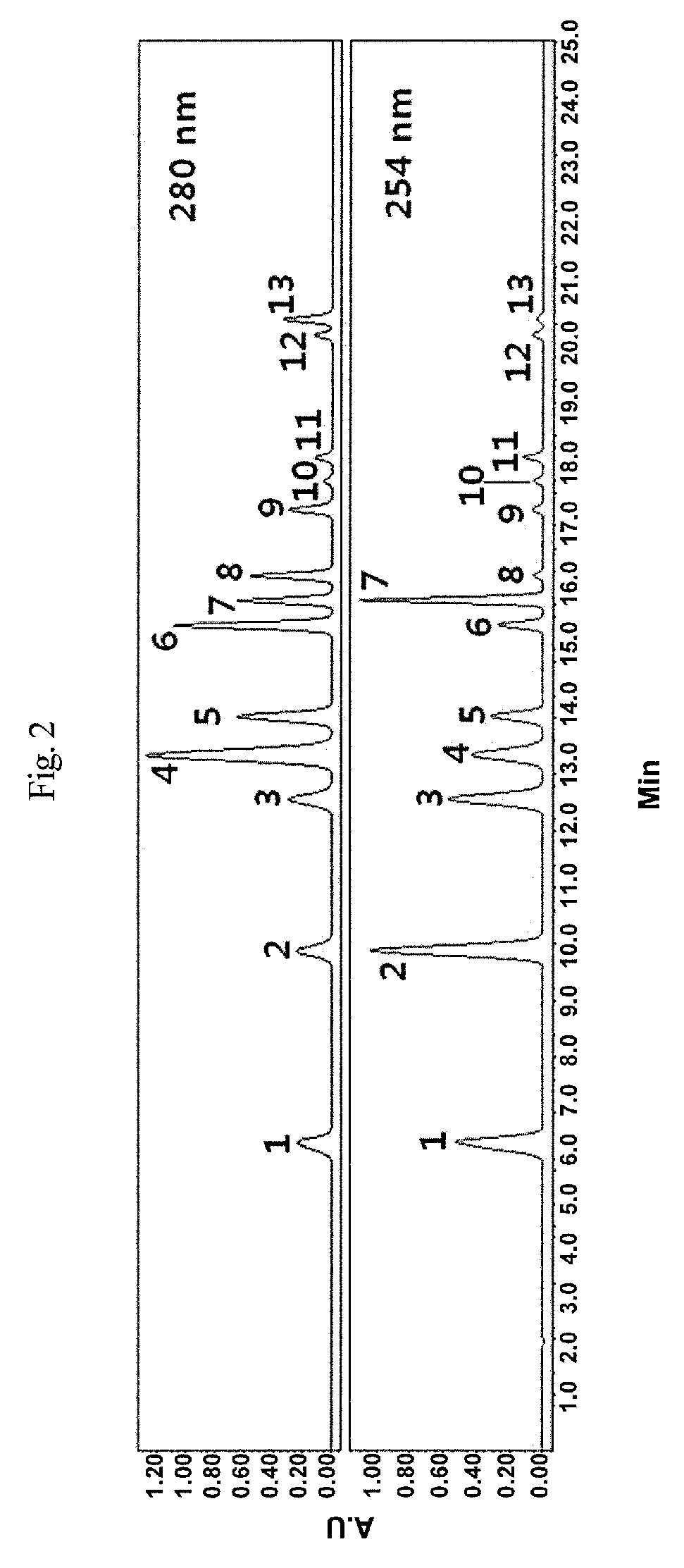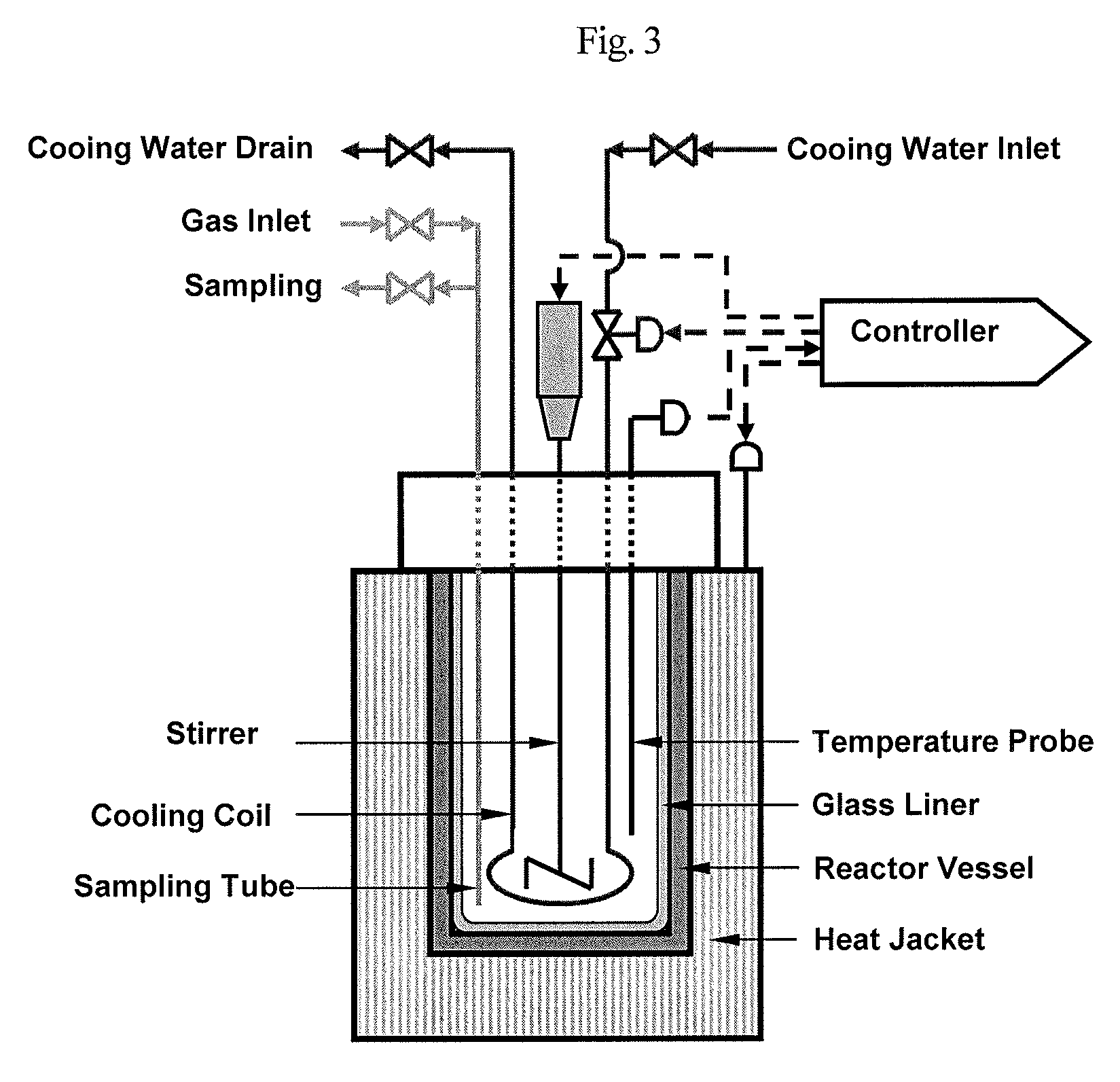Process of biologically producing a p-hydroxybenzoic acid
a biological process and p-hydroxybenzoic acid technology, applied in the preparation of carboxylic compounds, lyases, carbon-carbon lyases, etc., can solve the problems of high production cost, high temperature and high pressure, and environmental dangers for workers,
- Summary
- Abstract
- Description
- Claims
- Application Information
AI Technical Summary
Problems solved by technology
Method used
Image
Examples
example 1
Degradation of Lignin by Alkaline Oxidation
[0079]Lignin was degraded using a laboratory high-pressure reactor (450 mL, Parr 4562) shown in FIG. 3. A reactant with a lignin content of 5.0% (w / v) was prepared by adding 10.0 g of Kraft lignin to 200 mL of 1 M NaOH. The reactant was further mixed with 10 g of the catalyst KMnO4, loaded to a stainless steel high-pressure reactor with an internal volume of 450 mL, sealed, and stirred at a speed of 500 rpm. After the reactor was filled with oxygen gas at a pressure of about 5 bar for 2 min via a sampling line communicating with the interior thereof; it started to be heated. When the internal temperature of the reactor reached 140° C., the reaction was continued for 60 min. The reaction temperature was adjusted by a PID controller through a cooling water tube. At 60 min of the reaction, a sample was withdrawn via a sampling line, and then, the reaction was terminated.
[0080]Two mL of the sample containing alkaline breakdown products of ligni...
example 2
Production of p-Hydroxybenzoic Acid by Enzymatic Reaction
[0082] Construction of Recombinant Expression Vector Carrying Aminodeoxychorismate Lyase Gene and Preparation of Transformed Microorganism
[0083]To produce aminodeoxychorismate lyase (ADC lyase), an ADC lyase gene from S. cerevisiae was cloned. First, genomic DNA was isolated from S. cerevisiae KCCM 50712. On the basis of a nucleotide sequence (GenBank Accession Number; DAA10190.1) coding for the ADC lyase of S. cerevisiae KCCM 50712, the following primers were designed:
[0084]
(Forward primer):5′-AAACATATGTCACTAATGGACAATTGGAA-3′ (SEQ ID NO: 1)(Reverse primer):5′-AAACTCGAGATATTTTGTCTTCACTGTTC-3′ (SEQ ID NO: 2)
[0085]The nucleotide sequence of ADC lyase gene was amplified by PCR using the primers, with the genomic DNA of S. cerevisiae KCCM 50712 serving as a template.
[0086]A total volume of 50 μl of a PCR composition contained 100 ng of the template, 10 pmol of each primer, 2.5 mM dNTPs, a 1× PCR buffer, and a 2.5 U Taq polymerase....
example 3
Production of p-Hydroxybenzoic Acid Using Whole Cell
[0098]In place of purified enzyme, whole cells were used to produce p-hydroxybenzoic acid from vanillin.
[0099]For this, S. cerevisiae KCCM 50712 was incubated at 37° C. and 250 rpm for 24 hrs in a YPD medium containing glucose, and the cell culture was centrifuged at 4,000 g and 4° C. for 20 min. After the cell pellet thus formed was washed twice with a Tris-HCl buffer, the cells were incubated at 37° C. for 24 hrs in a Tris-HCl buffer containing 500 mg / L vanillin as substrate. After completion of the incubation, the culture was extracted with nine volumes of methanol, and the extract was filtered through a syringe filter (0.22 μm). Concentrations of p-hydroxybenzoic acid in the filtrate were examined by HPLC (Table 4).
[0100]
TABLE 4Concentration before Concentration afterenzyme reaction (mM) enzyme reaction (mM)p-hydroxybenzoic acid0.0000.018Vanillic acid0.0000.257Vanillin0.6500.133
[0101]As is apparent from the data of Table 4, van...
PUM
| Property | Measurement | Unit |
|---|---|---|
| concentration | aaaaa | aaaaa |
| pH | aaaaa | aaaaa |
| temperature | aaaaa | aaaaa |
Abstract
Description
Claims
Application Information
 Login to View More
Login to View More - R&D
- Intellectual Property
- Life Sciences
- Materials
- Tech Scout
- Unparalleled Data Quality
- Higher Quality Content
- 60% Fewer Hallucinations
Browse by: Latest US Patents, China's latest patents, Technical Efficacy Thesaurus, Application Domain, Technology Topic, Popular Technical Reports.
© 2025 PatSnap. All rights reserved.Legal|Privacy policy|Modern Slavery Act Transparency Statement|Sitemap|About US| Contact US: help@patsnap.com



